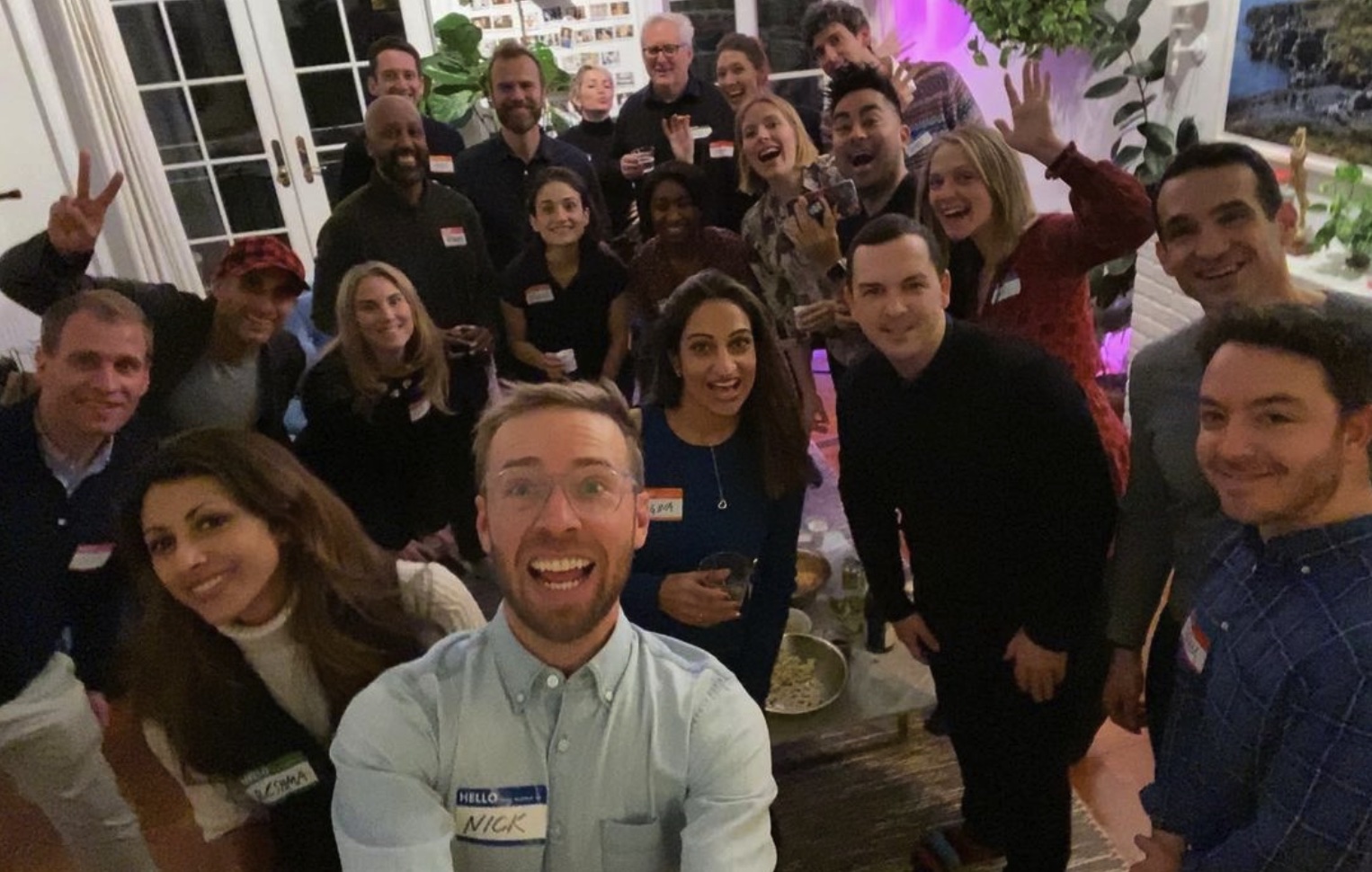
Nick Gray ('04) with friends helping him to test which name tags are best for parties.
Some people love hosting parties, and some dread it.
Some people make new friends everywhere they go, while many of us, especially well beyond our college years, acquire friendships rarely and slowly.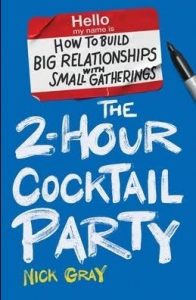
Nick Gray (’04), a successful entrepreneur who founded Museum Hack tours, has written a book, “The 2-Hour Cocktail Party,” for those of us who want to make new connections in our world.
“Nobody really teaches adults how to make new friends,” Gray says. “It is hard. And even now post-COVID people are lonely, and we’ve forgotten, sort of, how to gather. And it’s awkward.”
For those of us — this writer included — who fall into the dread-hosting-parties category, Gray’s book is appealing. We worry. Is the house too cluttered? Is it clean enough? Do we have enough food or the right food, enough drinks or the right drinks? Will no one show up or too many show up? Will guests be bored? Will the evening leave us in a blur of exhaustion, trying to persuade energetic stragglers to please go home, for Pete’s sake?
Gray has developed a magic formula, through trial and error in literally hundreds of parties over 15 years, even in tiny apartments in New York City. He has zapped the stress out of parties, made tons of new friends and produced happy connections among partygoers who nag him to hold the next party.

Gray comes down a water slide in Scottsdale, Arizona. Always about having fun, he shared on Instagram that with no waiting line, he rode the slide eight times.
Gray admits to a “dirty little secret.”
“I wrote a book called ‘The 2-hour Cocktail Party,’ and I don’t even drink alcohol,” he says. “I don’t know how to make a Manhattan to save my life. There’s not a single drink recipe in the book, but it’s about the people. And it’s about introducing your friends to other friends and mixing up your social groups and meeting new people.”
His book offers step-by-step directions, from how to phrase, deliver and time your invitations to some unexpected techniques that can be met with skepticism. But know this: Nick Gray has boundless energy for whatever he takes on, and he succeeds, so his advice is worth considering.
A business major with a Wake Forest Presidential Scholarship in entrepreneurship, he worked in Georgia after graduation selling audio and video equipment for private jets and military planes and moved to New York City in 2007. He fell in love with the Metropolitan Museum of Art. Taking his friends for a quirky, fun-filled tour there for his 30th birthday in 2011 led to more tours. He founded Museum Hack in 2013, selling unconventional tours of the Met.
The company expanded to other major museums around the country, giving tourists new ways to laugh and smile among the traditionally intimidating places where visitors felt they should speak only in whispers. He and his team served as consultants to museums on how to attract new audiences and to corporations on building teams.
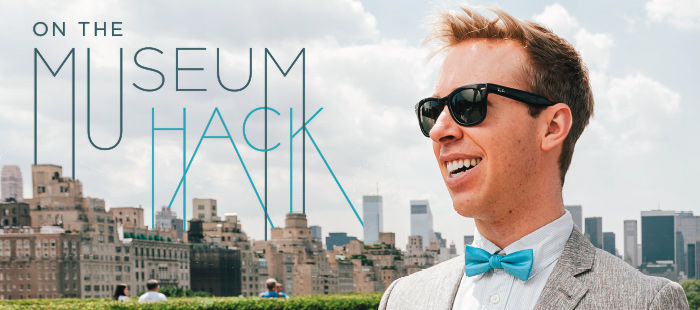
Gray founded Museum Hack to give fun, quirky tours of places many visitors expect to be formal, quiet and stuffy. He sold primary ownership of the successful company to CEO Tasia Duske and Director of Marketing Michael Alexis. Photo by Joe Anderson.
He sold the multimillion-dollar company to his colleagues in 2019, retaining a 15% share, and explored the world before settling in Austin, Texas, about 18 months ago.
He doesn’t face the demands of a regular job these days, but he can’t stop setting goals for himself. His current one is to entice 500 people to have their first “2-hour Cocktail Party.”
Wobbly beginning
His early life in New York City had involved going to too-loud bars and restaurants or parties where he felt uncomfortable and sat alone with his phone before heading home. He finally decided to create the kind of party he would like to attend, and so began his experiments.
“I had to learn through trial and error, and I’ve made a lot of mistakes along the way,” he says. “I’ve hosted a party where only two people showed up.”
At one party, he fussed over the food and the apartment so long he was late taking a shower and had to answer the doorbell soaking wet and wrapped in a towel when the first guest arrived early. But he persevered and refined the party process. He kept notes for five years before writing the book.
The N-I-C-K party guide
What are some of the key ingredients of the party? Choose a Monday, Tuesday or Wednesday night from 7 p.m. to 9 p.m. to keep it low-pressure with a definite ending and avoid competing with other popular times for social events. People will show up on time with a short window of time, and you and your guests can get a good night’s sleep. Your goal is 15 to 20 guests, and Gray lays out the precise steps over three weeks for reaching that number.
These are the N-I-C-K party guide basics. The book offers plentiful additional tips.
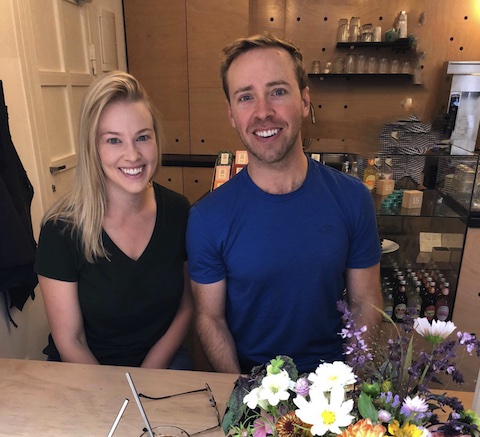
Gray with his sister, Emily, in Prague in 2018. Showing the sense of humor that led him to the Lilting Banshees comedy troupe at Wake Forest, he noted in the 2021 Instagram post of this photo that Emily was getting married the next day. "I'm thinking about all of our fun adventures together. Which we won’t be able to have anymore because soon she’ll have a deadweight husband. Hope he doesn’t see this. Sorry bro."
N for Name Tags
“A party without name tags is like a museum without labels for the paintings,” he says in his book.
Tags make the embarrassment of forgetting names almost impossible. They put everyone on equal footing because EVERYONE must wear one. He suggests that the host or a helper write the guests’ names — first name only — in black, block letters on a high-quality name tag (no cheap mailing labels that curl up and fall off or threaten silk fabric). This avoids unreadably scribbled names, long full names or fake names from rebel guests. (Yes, it happened to him once when guests wrote “Superman,” “Batman” and other joke names.) A name tag “signifies that there are no cliques at this party,” he writes, “… that guests haven’t walked into a room of best friends who already know each other.”
Tags also help make introverts or shy people feel safe and welcome, Gray says.
He even made waterproof name tags for his book’s launch party, literally launching his guests on paddle boards to float down Barton Creek in Austin.

Swimming in Austin
I for Icebreaker
This also can sound like a strange idea to some, but an icebreaker makes openings for new conversations. Gray says it’s about asking a simple, easy question, not cooking up the most creative or thought-provoking idea. You want short responses of 30 seconds or so, as all stand in a circle. “If you sit down, it’s kind of kryptonite for a high-energy environment,” he says.
The host goes first, sharing your name and your work — or your passion, for those who may not have a job. Then answer the question; a good choice is “What is your favorite breakfast?” It’s safe, yet guests can deduce some differences between a granola and blueberries person and someone like one of Gray’s guests who said she likes a cigarette for breakfast, to hearty laughter. Don’t ask for guests’ favorite book of all time, for example, because it requires too much reflection and vulnerability. The initial icebreaker happens around 7:10 p.m. with the first handful of guests, with a second round 40 minutes into the party when more people have arrived.
Go quickly around the circle, with no follow-up questions. Afterward, invite everyone to freshen their drinks, have snacks and follow up with someone.
At 75 minutes into the party, announce the third slightly more complex icebreaker question for the guests to mull, then at 80 minutes, reconvene for a group photo to be shared post-party and circle for the third icebreaker question. Gray likes “What piece of media have you consumed lately and what did you like about it?” Then back to mingling.
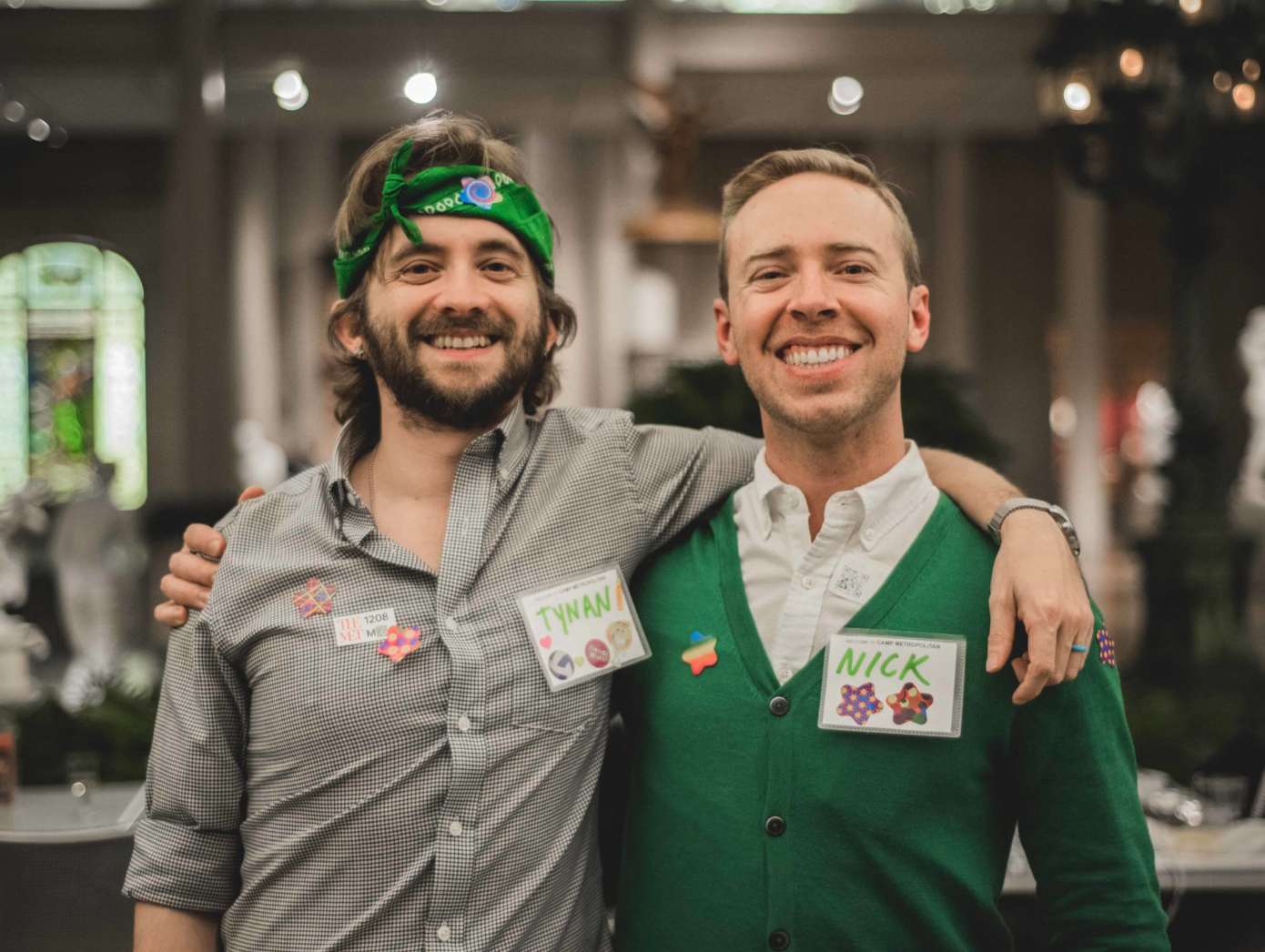
Gray and his friend, Tynan, at Gray's "summer camp" themed 36th birthday party at the Met in New York.
C for Cocktails
Cocktails only, no dinner parties. Gray recommends two bottles each of white and red wine, a bottle of whiskey and a bottle of vodka or tequila. For mixers, offer sparking water, cranberry or orange juice and diet and regular soda. Use clear disposable cups, not those red ones that recall dorm parties.
Keep food simple: a pound of baby carrots, 8 or 12 ounces of hummus, a pound of guacamole, two 15-ounce bags of chips, 16 ounces of salted nuts, a 2-pound cheese plate and 2 pounds of grapes.
Fun and engaging. This book is a proactive do-it-yourself guide to party hosting and network building.
K for Kick Them Out
Ten minutes before closing time, make a last call for alcohol and remind guests you promised to end at 9 p.m. In a city, you can recommend a nearby restaurant or bar for those who want to continue talking. Otherwise, you can suggest that people set a date to talk again. The bottom line, they must go! Guests should want more, rather than letting the party sizzle out.
Gray has extensive instructions on how to go about selecting guests, inviting them first by text, then following up with an online reservation app. He describes how to monitor your acceptances, share updates and offer reminders and info along the way, with examples.
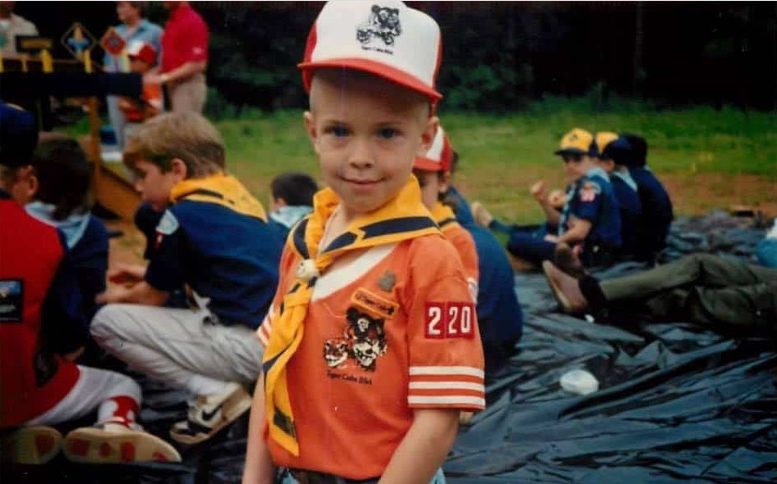
Gray as a Tiger Cub in a photo by his mother. An episode of "This American Life" about summer camps inspired his "Camp Metropolitan" theme for his 36th birthday party at the Metropolitan Museum of Art. What rang true for him was "the idea of teamwork, activities and having fun in a special place with rituals and traditions."
The energy of childhood
One of the defining characteristics of Gray’s Museum Hack and almost everything he does is an emphasis on fun, allowing his and others’ inner children to come out. How did that happen?
It took a while. He says he wasn’t popular in high school. “I certainly was never somebody in college (who was) hosting parties. (That) did not come naturally to me. … I’m such a nerd, and I spent all my time on the computer.” He created a computer business in his dorm room.
He credits joining the Lilting Banshees comedy troupe with ratcheting up the fun factor in his life. “If you were to tell somebody else, ‘Now, listen, you’re a freshman and you’re going to go on stage, and you’re going to try to make 800 people laugh in Brendle auditorium,’ that’s ridiculous. Being a part of that group was truly magical.’
He has mastered the art of being free to be silly. For his 36th birthday, he rented the Met for Camp Metropolitan, an evening of “summer camp” with his friends. They opened plastic Easter eggs in the Faberge egg exhibit room and pulled out bandanas, earned merit badges and more. All this was followed by a shuttle bus to an art gallery for food and a drum line.
When it comes to socializing, Nick is the most creative adult I know. Parties with him are unlike anything I've seen. He's a master at creating memories, easing social tension at parties, and facilitating new friendships."
What’s next?
After selling primary ownership of Museum Hack, Gray spent a nomadic period before settling in Austin, where he lives and writes a newsletter and articles: how to host a clothing swap, a watermelon crunch July 4th game or how to plan a networking event. He met his current circle of friends through his cocktail events.
For now, getting 500 people to launch a cocktail party is his laser focus, he says.
“If 500 people host a party for 15 to 20 of their friends, I can then reach and maybe impact 10,000 people through these parties. Sometimes our country can feel divided, or we can feel lonely and stuck behind screens. And even after COVID we just missed that human connection of meeting our neighbors and gathering and talking
“I love bringing my friends together, and it makes me so happy to see when my friends make friends with other friends.”


